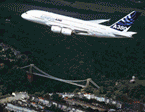|
|
On the Shoulders of Giants
Clive Leyman: Clive was Chief Aerodynamicist on the Concorde programme.
"If I have seen further it is only by standing on the shoulders of giants" – Isaac Newton
Most people who worked on the design of Concorde would agree that the success of the aircraft depended on two men who stood head and shoulders above the rest of us – Bill Strang and Mick Wilde.
When I first came to Bristol in 1957 I had thought I was going to work for the Bristol Aeroplane Company, but before I got there it had become Bristol Aircraft Limited. Bill was already a god-like being, the Chief Designer of the Britannia, who lived in a windowless office in No. 1 DO. Mick was at that time the Chief Aerodynamicist. Both became heavily involved in the early Supersonic Transport Aircraft Committee discussions that led to Filton winning the Concorde development contract. In 1960, following the government enforced merger of aircraft companies Bill became a director and Chief Engineer of the Filton Division of the new British Aircraft Corporation (but to most people at Filton BAC still meant Bristol Aeroplane Company!) In those days Filton still functioned almost as a family concern, and it was certainly a pleasant place to work. The Design Organisation was a happy unit, and a great deal of credit for this must go to Bill's leadership. A quietly spoken but forceful personality, Bill preferred to lead rather than drive.
Someone, I can't remember who, once remarked "My father was very even tempered – he was always angry". That could certainly not be said of Bill. Only twice in our long relationship did I see him lose his cool, once when some supplier's representative had done something to upset him and once when the DO decided to 'work without enthusiasm' at a critical point in the programme.
Working for him was nevertheless a challenge, for Bill possessed an extraordinary ability to pick up the essential features of whatever problem you had encountered and well before you had finished explaining it to him he had seen a solution and was asking you questions that you were certainly not ready to answer.
Mick, who by this time was Assistant Chief Engineer, was an entirely different character – more of an extrovert, with an incredible capacity for hard work, he also led by example, but in his case one felt one had to match his efforts.
These characteristics matched their contributions to the project. Concorde's politics were incredibly complicated – two lots of civil servants, two scientific civil service organisations, each subdivided into airframe and engine branches, four manufacturing companies each with their own subdivisions, and multiple airlines. Bill's interest lay in the structures and systems side of the design and he also looked after the 'civil service' side of the politics. Personal relationships can become very important even in formal contract situations and Bill established an excellent rapport with Jim (now Sir James) Hamilton who was Concorde Director-General from 1966 onwards. Mick's personality led him more towards sales activities and liaison with the airlines, especially with their Performance, Economics and Noise committee - subjects for which BAC had responsibility. This division of responsibilities worked very well.
In private life also their characters and hobbies matched. Bill was never happier than when sailing his beloved Olivia Ann along the coast of his native Devon, whereas Mick was an avid golfer who played off a handicap of six. One might almost say that Bill captained the ship and Mick did the driving!
An article such as this inevitably depends on personal reminiscences, so ...
Coming in on a conversation where Bill and Mick were bemoaning the fact that "they" would not agree to a particular course of action. Now we lesser mortals were quite accustomed to complaining that "they" would not allow us to do what we thought obviously correct, but it was a surprise to learn just how far up the tree "they" lived.
Bill would delegate – entering a room where he and Doug Thorne were poring over a graph of Concorde's empty weight against time, he flung it at me with the words "You aerodynamicists extrapolate everything – where is that going to finish up?"
On that famous afternoon of 2nd December 1962, a group of us sat in Mick's office on the upper floor of No. 4 DO looking out over the runway We heard the unmistakeable sound of an Olympus surge, saw white clad figures running like hell away from the Vulcan, saw the arrival of the fire engines and the two streams of blazing fuel run down the hill like the horns of a Zulu Impi to surround and engulf the brand new fire engine and watched in awe as the magnesium castings in the aircraft burned. A magnificent, if expensive, fireworks display, but one we could only watch surreptitiously, because throughout the whole process Mick did not once pause the meeting or even turn his head to see what was going on!
Two remarkable men with whom it was a privilege to work.
|







